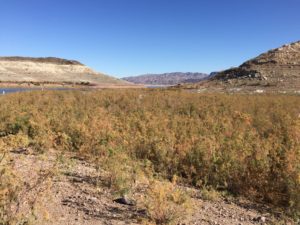LAS VEGAS, NV – When I stopped at Boulder Harbor on Lake Mead Tuesday morning as I drove into Las Vegas, I saw this field of salt cedar taking hold on what had been a mud flat left by Mead’s declining water levels. It’s a clumsy metaphor for what happens when you get comfortable with the levels of a 39 percent full/61 percent empty reservoir.
At this morning’s Colorado River Water Users Association plenary panel, five of the basin’s water management leaders spoke up about the status of the Drought Contingency Plan, the mystical “DCP”. A year ago at this meeting, the DCP seemed close, maybe (I boldly and perhaps naively argued) inevitable. The basic terms – specified water use cutbacks by Nevada, Arizona, and California as Lake Mead drops – have been in place for two years, now it’s just arguing over implementation details.
This year new problems have set in that, the morning panelists made clear, are making this seem harder, not easier. Chief among them is the struggle to get consensus within Arizona about how to accommodate shortfalls on the river, and seems to be getting harder, not easier. “Our challenge is growing, not contracting,” Arizona Department of Water Resources Director Tom Buschatzke said.
With Arizona an obvious holdout, California has taken a bit of a breather as well, to work out issues involving the Salton Sea, the Sacramento Bay-Delta, and the complicated relationship between the Metropolitan Water District of Southern California and Imperial Irrigation District. Met and IID say they are very close, so it seems like once Arizona sorts out its mess, California will be quick to finalize as well.
But that leaves the thorny question of federal legislation. It’s arcane, but there’s a belief among most of the basin states and the federal government that a legislative fix is needed to make DCP work, involving Interior’s authority to manage releases from Lake Mead during drought conditions. And OMG Congress, who wants to ask them to do an important thing right now? And if we do, should we tack on some other things that some of us have wanted to do Congressionally as well, as long as we’ve cracked open that pop-top?
But here’s the thing. Even though we don’t have DCP done, all the basin users are acting, operationally, like it’s a done deal. The states of the Lower Basin are leaving significant quantities of water in Lake Mead this year, kinda like if DCP was already in place. And, crucially, Nevada and Southern California seem to be presuming, in leaving that water in the lake, that the new rules for taking it out under drought conditions, embodied in DCP, will be in effect when they’re needed. Absent DCP, this would pose significant risk for them that they might not be able to get their water out of Lake Mead. This is a strong vote of confidence that DCP, while not done, soon will be.
Those salt cedars growing on Boulder Harbor’s mud flats are operating under the presumption that Lake Mead’s levels are stabilizing. Maybe it’s a vote of confidence in the DCP.


Speaking of Salt Cedars as a metaphor. I once had a conversation with someone about the new growth on the exposed banks on Lake Mead a while back. His take? New growth equates to new habitat. The opposite being more water being impounded will take away the habitat.
It got me to thinking on the lines on how complicated reservoir management actually is.
DG – I was thinking about this very thing last month when I stopped at Boulder Harbor, where a wide bed of salt cedar has sprung up as the water receded over to the right of the boat ramp. A mud flat I walked across a year ago (I think it was a year ago, not sure about the date) is now impassible. Go flycatchers!